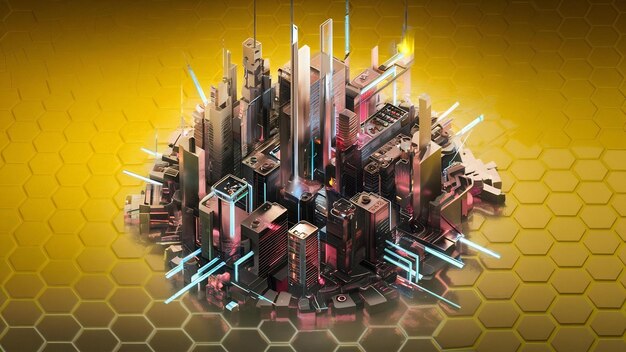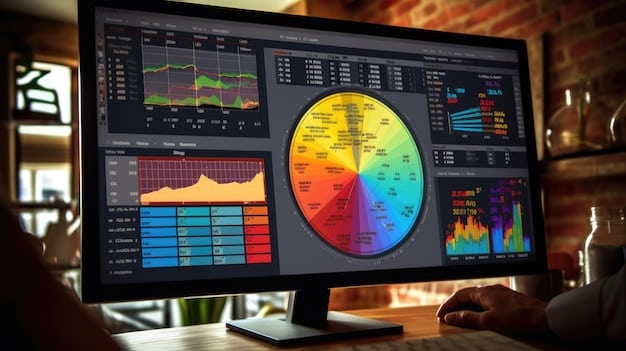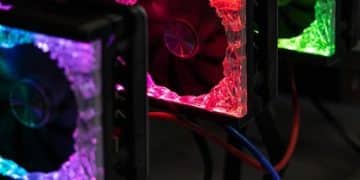AMD vs Nvidia GPUs in 2025: Key Differences You Need to Know

The key differences between AMD and Nvidia GPUs in 2025 will likely revolve around architecture advancements, ray tracing performance, AI integration, and pricing strategies, impacting gamers and professionals alike.
The world of graphics processing units (GPUs) is dominated by two titans: AMD and Nvidia. As we look ahead to 2025, understanding the key differences between AMD and Nvidia GPUs in 2025 becomes crucial for gamers, content creators, and anyone relying on powerful graphics processing. This article will delve into the anticipated changes and advancements, helping you make informed decisions about your next GPU purchase.
AMD vs Nvidia: A Landscape of Innovation in 2025
Navigating the GPU market can be daunting, especially with the rapid pace of technological advancements. By 2025, both AMD and Nvidia are expected to introduce new architectures and features that will significantly impact performance and user experience. This section explores the general trends and expectations for both companies.
Anticipated Architectural Changes
Both AMD and Nvidia are constantly pushing the boundaries of GPU architecture. We can expect to see improvements in power efficiency, core design, and memory bandwidth. Key considerations include:
- AMD’s RDNA Architecture: Look for further refinements in RDNA, potentially moving towards RDNA 5 or beyond. These advancements will likely focus on improving ray tracing performance and efficiency in compute tasks.
- Nvidia’s Ada Lovelace Successor: Nvidia’s next-generation architecture is expected to build upon the success of Ada Lovelace, offering enhanced AI capabilities and further optimizations for gaming and professional applications.
- Die Shrinks and Manufacturing Processes: Expect both companies to leverage advancements in manufacturing processes (e.g., moving to 3nm or beyond) to pack more transistors onto their GPUs, leading to increased performance and efficiency.
These architectural changes will be pivotal in determining the overall performance and capabilities of each company’s offerings.
Focus on Ray Tracing and AI
Ray tracing and AI-driven technologies are becoming increasingly important in modern GPUs. By 2025, both AMD and Nvidia will likely deepen their integration of these features:
- Enhanced Ray Tracing: Expect improvements in ray tracing performance, making it more accessible across a wider range of games and applications. This includes dedicated hardware improvements and software optimizations.
- AI Upscaling Technologies: AMD’s FidelityFX Super Resolution (FSR) and Nvidia’s Deep Learning Super Sampling (DLSS) will continue to evolve, offering better image quality and performance gains through AI-driven upscaling.
- AI-Assisted Content Creation: GPUs will play an increasingly important role in AI-assisted content creation, enabling faster and more efficient workflows for tasks like video editing, 3D modeling, and image processing.
The race to deliver superior ray tracing and AI performance will be a key battleground for AMD and Nvidia.
In conclusion, the landscape of GPUs in 2025 promises significant advancements in architecture, ray tracing, and AI, setting the stage for fierce competition between AMD and Nvidia.
Performance Benchmarks: What to Expect in 2025
Performance benchmarks are crucial for evaluating the real-world capabilities of GPUs. By 2025, we can anticipate significant improvements across various metrics, but the leading company may vary depending on the specific task. This section will cover key performance areas to watch.

Gaming Performance
Gaming remains a primary focus for both AMD and Nvidia. In 2025, expect to see:
- Higher Frame Rates: Next-generation GPUs will aim to deliver smoother gaming experiences at higher resolutions, such as 4K and beyond, with increased frame rates.
- Improved Ray Tracing Performance: Ray tracing will become more prevalent, and GPUs will need to handle it efficiently to maintain playable frame rates.
- Competitive Benchmarks: The competition between AMD and Nvidia will drive innovation, resulting in close performance battles in popular game titles.
Compute and Professional Workloads
Beyond gaming, GPUs are essential for compute-intensive tasks and professional applications. Key areas to consider include:
- AI and Machine Learning: Nvidia has traditionally held an advantage in AI and machine learning workloads, but AMD is making strides with its ROCm platform. Expect both companies to compete fiercely in this space.
- Content Creation: Tasks like video editing, 3D rendering, and simulations benefit from powerful GPUs. Performance will depend on the specific software and GPU architecture.
- Scientific Computing: GPUs are used in scientific research for tasks like simulations and data analysis. AMD and Nvidia both offer specialized GPUs for these applications.
The performance in compute and professional workloads will be a critical factor for professionals and researchers.
Power Efficiency
Power efficiency is an increasingly important consideration, driven by environmental concerns and the desire for cooler, quieter systems. Expect:
- Improved Efficiency: Both AMD and Nvidia will focus on improving the power efficiency of their GPUs, delivering more performance per watt.
- Advanced Cooling Solutions: Innovations in cooling technology will be essential to manage the heat generated by high-performance GPUs.
- Lower Power Consumption: Lower power consumption will be a key selling point, especially for mobile GPUs and energy-conscious consumers.
Power efficiency will play a crucial role in the adoption and sustainability of next-generation GPUs.
In summary, performance benchmarks in 2025 will showcase significant advancements in gaming, compute, and power efficiency, with AMD and Nvidia vying for the top spot in various categories.
Pricing Strategies and Market Positioning
Pricing strategies and market positioning are critical factors influencing consumer choices. By 2025, the GPU market is expected to continue evolving, with potential shifts in pricing models and target audiences. This section examines how AMD and Nvidia might position themselves in the market.
Entry-Level to High-End GPUs
Both AMD and Nvidia offer a range of GPUs catering to different budgets and performance requirements:
A tiered approach to GPUs, from entry-level to enthusiast-grade options, will continue to be the standard as both of the major providers continue to grow in popularity
- Entry-Level: Affordable GPUs for basic gaming and general-purpose tasks.
- Mid-Range: Balanced performance and price for mainstream gamers and content creators.
- High-End: Premium GPUs for enthusiasts and professionals demanding the best possible performance.
Impact of Manufacturing Costs
Manufacturing costs play a significant role in determining GPU prices. Factors to consider include:
- Die Size and Complexity: Larger and more complex GPU designs are more expensive to manufacture.
- Manufacturing Process: Advanced manufacturing processes (e.g., 3nm) are costly but enable higher performance and efficiency.
- Supply Chain: Disruptions in the supply chain can impact availability and prices.
Efficient supply chain management and optimized manufacturing processes will be crucial for maintaining competitive pricing.
Bundling & Software Offerings
Bundling and software offerings can add value to GPUs and influence purchasing decisions:
Additional value can be given thanks to the bundling of software with particular units, adding perceived value and affecting customer decisions
- Game Bundles: Bundling GPUs with popular game titles can attract gamers.
- Software Suites: Offering free or discounted access to professional software can appeal to content creators.
- Exclusive Features and Technologies: Differentiating GPUs with unique features and technologies can justify premium pricing.
Adding value through bundles and software offerings can be an effective strategy for both AMD and Nvidia.
In conclusion, pricing strategies and market positioning in 2025 will depend on factors like manufacturing costs, market demand, and the competitive landscape, with AMD and Nvidia constantly adapting to maintain their positions.
Technological Advancements: Beyond Raw Power
Technological advancements extend beyond raw processing power, encompassing innovative features and technologies that enhance the user experience. By 2025, expect to see several key advancements shaping the GPU landscape. This section explores these technological innovations, highlighting their potential impact.

Memory Technologies
Memory technologies play a crucial role in GPU performance, enabling faster data transfer and improved bandwidth. Key advancements include:
- GDDR7: Expect the adoption of GDDR7 memory, offering higher bandwidth and improved efficiency compared to GDDR6 and GDDR6X.
- HBM (High Bandwidth Memory): HBM may become more prevalent in high-end GPUs, providing even greater bandwidth for demanding workloads.
- On-Package Memory: Integrating memory directly onto the GPU package can reduce latency and improve overall performance.
Advancements in memory technologies will significantly impact GPU performance in gaming, content creation, and scientific computing.
Cooling Solutions
Effective cooling solutions are essential for managing the heat generated by high-performance GPUs. Innovations in cooling technology include:
- Advanced Air Cooling: Improved heatsink designs and fan technologies for efficient heat dissipation.
- Liquid Cooling: All-in-one (AIO) liquid coolers and custom liquid cooling loops for superior cooling performance.
- Vapor Chamber Technology: Vapor chambers for efficient heat transfer from the GPU die to the heatsink.
Advanced cooling solutions will enable GPUs to maintain high clock speeds and deliver optimal performance under sustained loads.
Connectivity and Interfaces
Connectivity and interfaces are crucial for connecting GPUs to other components and devices. Key advancements include:
- PCIe 6.0: Adoption of PCIe 6.0 will provide higher bandwidth and improved data transfer rates between the GPU and the CPU.
- DisplayPort 2.1: DisplayPort 2.1 will enable higher resolutions and refresh rates for gaming and professional displays.
- USB-C Connectivity: USB-C ports with DisplayPort Alternate Mode for connecting to external displays and devices.
Improved connectivity and interfaces will enhance the versatility and compatibility of GPUs.
In summary, technological advancements beyond raw power, such as memory technologies, cooling solutions, and connectivity, will play a significant role in shaping the GPU landscape in 2025.
Software Ecosystems and Driver Support
The software ecosystem and driver support are critical components of the GPU experience. Robust software and reliable drivers can significantly enhance performance, stability, and compatibility. By 2025, both AMD and Nvidia are expected to continue investing in their software ecosystems. This section examines the key aspects of software support.
AMD’s Software Suite
AMD offers a comprehensive software suite designed to optimize the performance and capabilities of their GPUs. Key components include:
- AMD Adrenalin Software: Provides tools for monitoring GPU performance, customizing settings, and streaming gameplay.
- AMD FidelityFX Super Resolution (FSR): AI-driven upscaling technology for improving performance in games.
- AMD ROCm: An open-source platform for GPU-accelerated computing, targeting AI, machine learning, and scientific research.
Nvidia’s Software Ecosystem
Nvidia boasts a well-established software ecosystem that includes:
- Nvidia GeForce Experience: Offers driver updates, game optimization, and recording/streaming capabilities.
- Nvidia Deep Learning Super Sampling (DLSS): AI-driven upscaling technology for improving performance and image quality in games.
- Nvidia CUDA: A parallel computing platform and programming model for GPU acceleration in various applications.
High-quality and reliable drivers are important aspects to consider when shopping for new GPUs, so finding the best support is important
Driver Stability and Updates
Driver stability and timely updates are essential for a positive user experience. Key considerations include:
- Regular Updates: Both AMD and Nvidia release regular driver updates to address bugs, improve performance, and add support for new games and features.
- Stable Releases: Ensuring driver stability is crucial to prevent crashes, glitches, and other issues.
- Community Feedback: Actively engaging with the community and addressing user feedback can help improve driver quality.
Robust software support, timely updates, and reliable drivers are crucial for maximizing the performance and usability of GPUs.
A solid software ecosystem and dependable driver support are absolutely essential for maximizing the user experience and guaranteeing the best possible performance, both AMD and Nvidia want to take charge of their product
Future Trends and Predictions
Looking further into the future, several trends and predictions are shaping the GPU landscape beyond 2025. These trends include advancements in integration, cloud gaming, and new applications. This section explores these forward-looking trends.
Integration with CPUs
The integration of GPUs with CPUs is becoming increasingly common, blurring the lines between discrete and integrated graphics. Key trends include:
- APUs (Accelerated Processing Units): AMD’s APUs combine CPU and GPU cores on a single chip, offering improved performance and efficiency for integrated graphics solutions.
- Integrated Graphics: Intel and other CPU manufacturers are also enhancing their integrated graphics solutions, providing better performance for everyday tasks and light gaming.
- Chiplet Designs: Chiplet designs allow for combining different CPU and GPU components on a single package, enabling greater flexibility and customization.
An APU could become the standard for new hardware as time goes on and the technology improves
Cloud Gaming and Streaming
Cloud gaming and streaming services are gaining popularity, allowing users to access games and applications from anywhere with an internet connection. Key trends include:
- GPU Virtualization: Technologies like Nvidia vGPU enable multiple users to share a single physical GPU in the cloud, optimizing resource utilization.
- Low-Latency Streaming: Reducing latency is crucial for providing a responsive and enjoyable cloud gaming experience.
- Scalable Infrastructure: Cloud gaming providers need to build scalable infrastructure to handle a large number of concurrent users.
New Applications and Use Cases
GPUs are finding new applications and use cases beyond gaming and professional graphics. These include:
- Autonomous Vehicles: GPUs are used for processing sensor data and making real-time decisions in autonomous vehicles.
- Virtual and Augmented Reality: High-performance GPUs are essential for delivering immersive VR and AR experiences.
- Scientific Simulations: GPUs are used for running complex simulations in fields like climate science, drug discovery, and materials science.
In conclusion, future trends and predictions point to greater integration with CPUs, the growth of cloud gaming and streaming, and new applications for GPUs in emerging fields.
| Key Aspect | Brief Description |
|---|---|
| 🚀 Architecture | Expected advancements in AMD’s RDNA and Nvidia’s architectures, enhancing performance and efficiency. |
| 💡 Ray Tracing & AI | Continued improvements in ray tracing tech and AI-driven features like DLSS and FSR offering better visuals and performance. |
| 💰 Pricing | Pricing strategies and bundling will affect consumer decisions, aiming to balance cost with performance. |
| 🎮 Gaming Performance | Higher frame rates and gaming performance across high resolutions, and high-intensity games. |
FAQ
▼
AMD is expected to further refine its RDNA architecture, potentially moving towards RDNA 5 or beyond. These advancements will likely focus on improving ray tracing performance and efficiency in compute tasks.
▼
Nvidia’s next-generation architecture is expected to build upon the success of Ada Lovelace, offering enhanced AI capabilities and further optimizations for gaming and professional applications. This includes enhanced AI upscaling technologies.
▼
Both AMD and Nvidia are expected to leverage advancements in manufacturing processes (e.g., moving to 3nm or beyond) to pack more transistors onto their GPUs, leading to increased performance and efficiency.
▼
Expect improvements in ray tracing performance, making it more accessible across a wider range of games and applications. This includes dedicated hardware improvements and software optimizations from both AMD and Nvidia.
▼
AMD’s FidelityFX Super Resolution (FSR) and Nvidia’s Deep Learning Super Sampling (DLSS) will continue to evolve, offering better image quality and performance gains through AI-driven upscaling, enhancing gaming experiences.
Conclusion
As we look to 2025, the competition between AMD and Nvidia promises to deliver exciting advancements in GPU technology. Key differences will likely revolve around architectural improvements, ray tracing capabilities, AI integration, and pricing strategies, ultimately benefiting gamers, content creators, and professionals alike.





